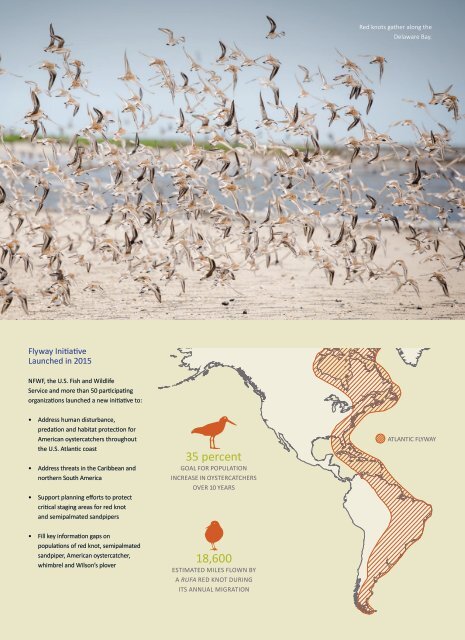NATIONAL FISH AND WILDLIFE FOUNDATION
2015_annual_report
2015_annual_report
Create successful ePaper yourself
Turn your PDF publications into a flip-book with our unique Google optimized e-Paper software.
Red knots gather along the<br />
Delaware Bay.<br />
GUIDING INVESTMENTS ALONG THE<br />
ATLANTIC FLYWAY<br />
Flyway Initiative<br />
Launched in 2015<br />
NFWF, the U.S. Fish and Wildlife<br />
Service and more than 50 participating<br />
organizations launched a new initiative to:<br />
Since 1995, one particularly well-traveled red knot has flown<br />
far enough to make it to the moon and back.<br />
Each year, this individual bird banded with the number B95 undertakes an epic southward<br />
journey, from arctic breeding grounds through the U.S. Eastern Seaboard, then across the<br />
Caribbean Sea to South America and on to the very tip of Chile, where he winters along<br />
desolate coastal beaches.<br />
To endure such long journeys, B95 and his fellow red knots undergo extensive physical<br />
changes. Flight muscles enlarge while leg muscles shrink. Stomachs and gizzards decrease<br />
while fat mass increases by more than 50 percent. Even with such amazing adaptations, red<br />
knots still require stopover habitats rich in easily digested foods.<br />
Each spring, red knots and other shorebirds depend on the Delaware Bay as one such<br />
stepping-stone on their journey back north. There, they fatten up on horseshoe crab eggs<br />
before tackling the last leg of their migration<br />
over vast boreal forest to their summer<br />
The loss or degradation of just one critical<br />
breeding grounds on the tundra.<br />
stopover site can put an entire population of<br />
The loss or degradation of just one of these<br />
migrating shorebirds at risk.<br />
stopover sites can put an entire population<br />
of red knots or other shorebirds at risk. In fact,<br />
more than 50 percent of the 75 species of shorebirds in North America are suffering drastic<br />
population declines.<br />
Over the past seven years, NFWF has worked with conservation partners along the Atlantic<br />
Flyway to reverse the decline of one such shorebird: the American oystercatcher.<br />
21<br />
• Address human disturbance,<br />
predation and habitat protection for<br />
American oystercatchers throughout<br />
the U.S. Atlantic coast<br />
• Address threats in the Caribbean and<br />
northern South America<br />
• Support planning efforts to protect<br />
critical staging areas for red knot<br />
and semipalmated sandpipers<br />
• Fill key information gaps on<br />
populations of red knot, semipalmated<br />
sandpiper, American oystercatcher,<br />
whimbrel and Wilson’s plover<br />
35 percent<br />
GOAL FOR POPULATION<br />
INCREASE IN OYSTERCATCHERS<br />
OVER 10 YEARS<br />
18,600<br />
ESTIMATED MILES FLOWN BY<br />
A RUFA RED KNOT DURING<br />
ITS ANNUAL MIGRATION<br />
ATLANTIC FLYWAY<br />
NFWF identified key threats to oystercatchers and developed strategies to address<br />
them. The Foundation then made strategic investments to reduce nest predation and<br />
human disturbance, increase stewardship efforts and monitor populations. In response,<br />
oystercatchers have rebounded, and in 2015 were on target to show a 35-percent increase<br />
over a 10-year period.<br />
Seeking to replicate this success with other shorebird species, NFWF worked with<br />
government, conservation and academic partners in 2015 to launch the Atlantic Flyway<br />
Shorebird Initiative.<br />
The new Flyway Initiative expands this highly collaborative model, giving scientists,<br />
biologists, refuge managers, private landowners and others a new opportunity to address<br />
threats common to 15 focal species across the Atlantic Flyway. The initiative also provides<br />
a framework to focus resources at critical stopover sites in the United States and elsewhere.<br />
CONTRIBUTING PARTNER U.S. Department of the Interior’s U.S. Fish and Wildlife Service


